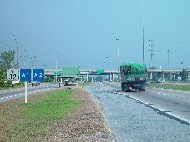Return to the Silk Road
Lost for generations, the fabled Silk Road is to be re-laid as a spider’s web of routes linking cities as distant as Tokyo, Istanbul, Helsinki and Bhutan.

The ambitious plan was agreed on at a series of meetings in Beijing at the end of April.
The United Nations Economic and Social Commission for Asia and the Pacific intend to bring the ancient camel routes by which the East and West traded even before the time of Marco Polo into the 21st century.
“People throughout Asia – leaders, businesspeople and ordinary citizens – have long dreamed of an efficient and reliable transport system that would link their countries in webs of prosperity and exchange,” said Kim Hak-su, the South Korean executive secretary of the commission in a statement.
“Today, with the signing of the Intergovernmental Agreement on the Asian Highway Network, that vision is becoming a reality,” he added.
Cooperation
The network of roads, bridges and ferry routes will stretch more than 140,000km and 24 Asian nations have already signed the treaty. Eventually, at least 32 nations are expected to have a hand in the project.
Funding for the preliminary work has come mostly from Japan, while China and South Korea are expected to contribute heavily to subsequent stages, along with the World Bank and the Asian Development Bank.
|
“It’s attractive politically, but I have a hard time imagining a truck being driven from Beijing to Paris. That’s just not an economical way of delivering goods” Dr Vladimir Ivanov, |
According to the UN, public-private partnerships will be encouraged to finance the project if there is a shortfall in funds provided by individual nations.
And even though the final price tag is likely to be astronomical and the construction work challenging, a target date of 2010 has been set for the completion of the network.
Business opportunity
“For a lot of Japanese companies, this will be an excellent opportunity to expand their operations into mainland Asia and develop new markets,” said Makoto Watanabe, a professor of communications at Hokkaido University.
“A lot of firms in the construction sector, in particular, are still suffering because of the economic downturn at home, so they will be watching developments on this front very closely,” he said.
The routes will also give Japanese companies access to the emerging markets of the Middle East and South-East Asia, and open up more areas with the natural resources that Japan needs to drive its economy.
 |
|
Project managers hope network |
For lesser economic lights in Asia, the road will also prove important it is hoped.
Landlocked countries such as Bhutan, Kazakhstan, Laos, Mongolia, Uzbekistan, Kyrgyzstan and Nepal will be able to access new markets, while spurs will branch out as far as the most easterly islands of the Indonesian archipelago, relying heavily on inter-island ferries.
“Asia‘s future … is closely entwined with the process of globalisation and the rapid spread of information technologies,” said Kim.
“But infrastructures such as highways and roads have just as crucial a role to play in creating opportunities for economic growth and social progress, and in overcoming the region’s widespread poverty and inequality.”
Route
Asian Highway One will be the starting point for the entire network, linking Tokyo with the Asian mainland by ferry before traversing China, the former Soviet republics, Iran and ending in Istanbul.
And the UN is keen to point out that while the task sounds daunting, more than 80% of the roads, bridges and facilities for people using the routes are already in place and will only need upgrading or repairing.
UN officials estimate that $16 billion will need to be spent on upgrading existing roads and providing new signs alone.
But there are others who question the motives behind the entire project.
“I think it’s clear that this is motivated more by politics than by economics,” said Dr Vladimir Ivanov, an economist at the Institute of North-East Asia, in Niigata, northern Japan.
|
“Leaders, business people and ordinary citizens have long dreamed of an efficient and reliable transport system that would link their countries in webs of prosperity and exchange” Kim Hak-su, |
“I’ve spoken to a number of historians and experts on the ancient Silk Road and they all say that it never operated as a single, integrated trunk route,” he said.
“It was always just sections that were interlinked and goods were transported a certain length along it, in one direction or the other, before being delivered to intermediate terminals for onward shipment.
“And that’s exactly what happens today anyway,” he said.
Political motives
“It’s attractive politically, but I have a hard time imagining a truck being driven from Beijing to Paris. That’s just not an economical way of delivering goods,” he said.
“A trans-continental transportation scheme is a good idea, of course,” he added, “but we already have one. The trans-Siberian railway links Europe with Beijing and it is the most economic way of moving goods over that distance. I think that in the end, economics will decide which prospers.”
And maybe Ivanov’s point about the political nature of the scheme is not far off the mark.
“As countries and people set off down this road, I hope we will see the same spirit of common purpose that enabled governments to resolve their differences and produce this agreement,” Kim told the UN meeting in Beijing.
“Our destination is clear: the Millennium Development Goals, and a world of stability, well-being and peace. Let us travel there together.”